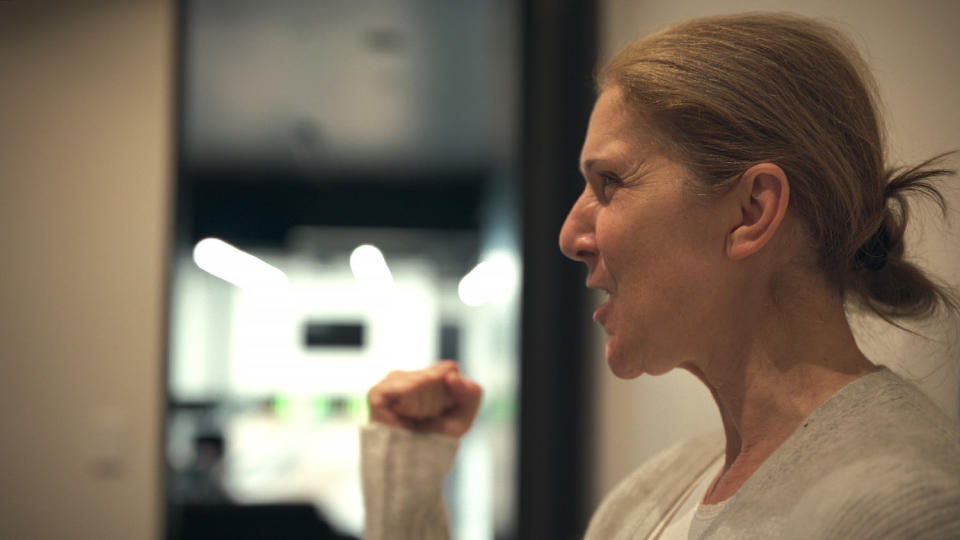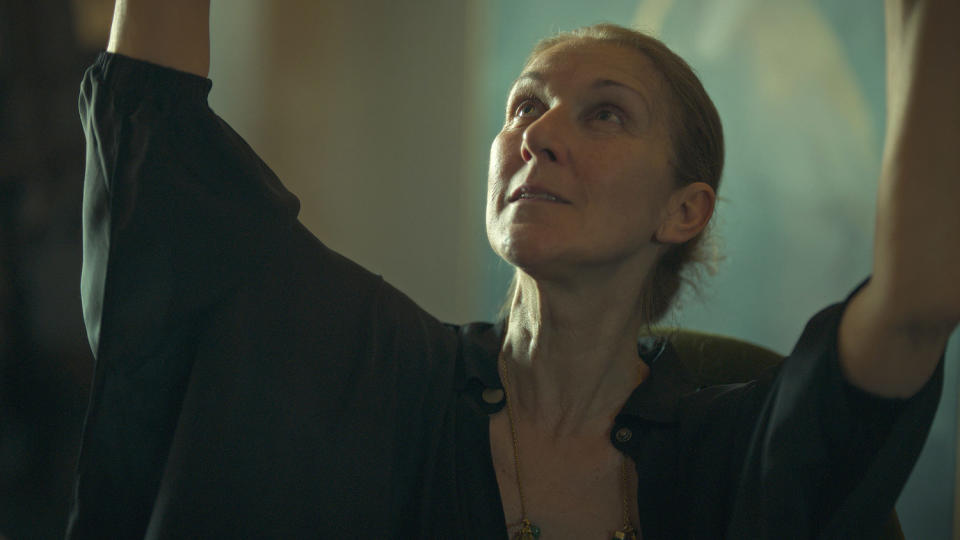Celine Dion has lived with the symptoms of stiff person syndrome for 17 years, she reveals in a new documentary detailing her life with the condition, “I Am: Celine Dion.” A particularly poignant scene near the end of the film shows up close the most serious effects of the disease, which cause muscle stiffness and painful spasms.
In the scene, Dion undergoes a physical therapy session shortly after viewers saw her record a new song, “Love Again.” She follows what appear to be standard exercises with her physical therapist, as part of her treatment efforts to improve her health and hopefully start again.


Then she begins to feel cramps in one of her legs, and within minutes her entire body is tense to the point that she can no longer speak, move, or even change her facial expression, which is distorted by the pain.
Celine Dion suffers medical crisis in documentary
As her medical crisis continues, her face glimmers with silent tears. Her physiotherapist asks her to squeeze his hand if she hears it. She remains motionless and cowered, but finds a way to show him that she is aware of what is happening to her and around her.
During the scene, Dion is given a benzodiazepine nasal spray, her doctor, Dr. Amanda Piquet, director of the autoimmune neurology program at the University of Colorado School of Medicine, Anschutz Medical Campus, told TODAY.com . It is part of a class of depressant medications that relieve anxiety and reduce muscle spasms.
The film doesn’t make it clear how long Dion’s spasms last, but eventually her muscles calm down enough that she can sit up and talk again. A member of his team speculates that his enthusiasm for singing earlier may have played a role in the attack of stiff person syndrome. The music legend then wonders aloud how she will ever be able to perform again if an intimate recording session could cause a medical crisis.
The film’s director, Irene Taylor, recalled what it was like to witness that scene in a recent interview with TODAY’s. Hoda Kotb. “It was the most extraordinarily uncomfortable moment of my life, as a filmmaker but also as a mother, as a fellow human being, because I didn’t know what was happening,” Taylor said.
“I had this uncertainty about whether I should continue filming or not. But (Céline) gave me the strength to continue. At that point, we had been filming together for several months, so she really encouraged me to formed, ‘Keep going.’ I have to stop you, I will stop you.’”
“Her body was going through something unimaginable, and I wasn’t sure she was aware of it,” Taylor continued. “I wasn’t sure she would survive it. It was really hard to sit next to her and talk about it out loud because it was so intense. »


Dion responded, “I just want you to know you did the right thing. I’m sorry it was difficult.”
Reflecting on her severe bouts of stiff person syndrome, Dion told Hoda that she used to “lose it for two hours without knowing it.” When she started getting it, she was like, “Okay, it’s going to be okay. (But) then you have trouble walking, and then you’re empty for two hours, and you’re like, what happened? “What is an attack of stiff person syndrome?
Many patients with Stiff Person Syndrome experience constant muscle cramps, spasms and stiffness, but certain movements or emotions can trigger “a full body spasm,” according to Piquet, a Stiff Person Syndrome advisory board member. Research Foundation. explain.
Recalling the scene of Dion’s full-body spasm, which began in his leg, Piquet says: “This anxiety, this panic, this continuous spasm that was not breaking, then very quickly triggered a complete spasm of everything the body.”
“It’s not a crisis,” says Dr. Piquet. “It’s a spasm that happens and patients are aware of what’s happening. There’s a lot of anxiety, a lot of panic, the adrenaline is pumping. »
David Axelrod, 36, of Milford, Connecticut, experienced similar episodes due to his stiff person syndrome.
“The minor side of a severe spasm is, for example, if I yawn too hard or chew in a strange way, my whole neck and throat will be in spasm, and the muscle will bulge, and my jaw stays open and I just have to breathe through it, give it a little warmth and try to calm it down,” he explains.
But “the worst kind,” he says, is a spasm that extends from the ribcage to the abdomen and down the back. “I turn into a layer of solid muscle, and you can even see the individual muscles spasming. … This causes my back to arch, which causes my back, legs and arms to spasm as well. It so is basically a full body spasm, I can’t move, and it can sometimes last up to a few hours.
“If I’m lucky and someone is nearby, they can get me a hot compress, and I apply the hot compress and pressure on it and that can help relieve it,” adds Axelrod. “Sometimes it happens when I’m alone and I can’t get up, I can’t move, I just have to lie there.”
He describes the pain as “a charley horse times 100. Sometimes you can barely breathe.” And the mental load is also overwhelming.
“(You think), ‘Oh no, oh no, oh God, please don’t let this happen,'” Axelrod says. “It’s a panicky moment. It’s not a fun experience to go through that. But I’ve definitely found that trying to stay calm and breathe deeply during it has a positive effect on it.”
These types of episodes are more common in patients whose symptoms are uncontrolled, according to Piquet. Axelrod adds that he’s more likely to experience it when he’s dealing with other stressors in his life. At a previous job, he had them several times a week.
What did Celine Dion say about her recovery?
According to Piquet, Dion has made “significant progress” in managing his symptoms since filming the documentary. Dion shared in the film that her treatment regimen involves physical therapy, intravenous immunoglobulin (which helps with the autoimmune aspect of stiff person syndrome), and muscle relaxers.
She said she can’t wait to get back on stage soon, although she doesn’t have a specific date yet. Dion said it’s possible that when she returns, she’ll have to cancel shows to prioritize her health, but she’s always keeping a positive attitude.
“I have to trust myself. I have to trust my team. I have to trust my voice. I’ve been through some tough things, but we all do,” she told Hoda. “But a lot of joy too. I’m about to experience a lot of happiness.”
This article was originally published on TODAY.com